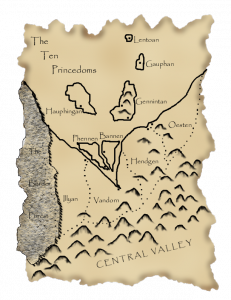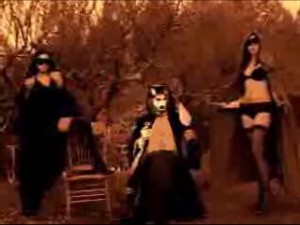Fringilla Monk
The Fringilla monks are acclaimed vintners who live in the isolated hilltop monastery Kloster Finch in Ettal Valley among the birds and their alchemical concoctions. In addition, they are mixologists that excel at making potions that bring joy and a mellow state in the populace. Through these concoctions, the people of the nearby towns of Garlston and Harlsbridge have come to appreciate and even revere the monks over the past twenty or more years.
However, more recently, the hills have grown more wild, ettins and ogres finding their way into the countryside, and the monks have modified their mixes with an aim toward incapacitating these foes. These once-peaceful monks have also been forced to take up martial arts in recent years in response to these external pressures. They combine tai chi with judo to embody a form of martial discipline that uses their attackers’ momentum against them, a technique which they have now begun to train the people of Garlston in.
Their brotherhood has grown so fast that they have begun construction of a new wing of the monastery. This has not been without a certain amount of political upheaval, as many of these new brothers are still naive to the more spiritual practices of the brotherhood. As such, a distinct caste-like structure has developed as a hierarchy within the brotherhood, with the elder monks enjoying some hypocritical leisure time while the young recruits learn their discipline.
A typical Fringilla monk has a high strength and a high dexterity and is spiritually aware. Many of the monks are privy to the highly specialized alchemy employed in the monastery, so they will have the brew potion feat, for which they only pay half the cost of normal brewing costs, since they pay the difference with their penance. In addition, all the monks know their fringilla style martial art, which provides a +1 to their base attacks, and another +1 if more than one monk engages a single foe.
Posted in Uncategorized and tagged nation or organization, Northbay by Stephen Hilderbrand with no comments yet.
The Ten Princedoms
 After King Vandor passed, his kingdom fell into the hands of his ten sons, none of whom agree on how the land should be run, so each have moved into separate residences and have defined ten states which they each administer. It’s a tenuous peace, but a peace nonetheless.
After King Vandor passed, his kingdom fell into the hands of his ten sons, none of whom agree on how the land should be run, so each have moved into separate residences and have defined ten states which they each administer. It’s a tenuous peace, but a peace nonetheless.
They have a sister, the youngest child, who has disappeared following Vandor’s death; rumor has it that she has become a witch in the neighboring Phyloctæte.
The mainland states and islands and their princely rulers, in order of birth (age in parens):
Vandorn is the central mainland part of the old Kingdom of Vandor. It is ruled by the sickly prince Hanik (38), the eldest son of Han. The Shankil and Dromgul Rivers come together just to the east of the city of Hanton.
Oesten is the easternmost mainland part of the Ten Princedoms. It has a bit of a frontier feel to it, which Ernik (36) hopes to take advantage of. He is trying to move the border east into unclaimed lands.
Hendgen is nestled between Vandorn and Oesten. Tanith (33) runs this state from Edige, the city over the river of the same name that runs from hills of still the same name.
Illyan is the westernmost mainland state. On the western edge, the Border Forest serves as a buffer from the Phyloctæte, a strange land of unexplained magics. Kres (31) has gained a lot of popularity throughout the Princedoms by keeping the military strong and the border protected.
The islands:
Gennintan is the rocky island north of the mainland. It is administered out of the west-central city of Gennt by the fifth child, Pan (29). The south end of the island is full of natural resources, and the north end of the island is protected to the point of being only partially explored.
Gauphan is the island north of Gennintan, ruled by Garles (27), who tries to steer clear of his elder brothers’ powermongering. He is still sometimes drawn into disputes, along with this younger brothers, but constantly complains about it and often withholds his support until the last minute, when he usually sides with the underdog.
Phennen is the west of the twin islands just north of Vandorn. Fain (25) lives in the old mage tower on the south end of the isle, with views of the twin isle and the mainland.
Bannen is the east of the twin islands just north of Vandorn. Klaran (23) lives in the castle which now bears his name on a hill overlooking the strait on the west end of the isle.
Hauphingan is the green isle to the northwest of other states, ruled by Hain (22). The verdant fields produce a sweet wine that is enjoyed throughout the Ten Pricedoms.
Trochu (also known as Lentoan) is a tiny island to the far north of the Ten Pricedoms, ruled by Launce (19). The mage Djander has been known to inhabit the island, and is possibly influencing the decisions of the young ruler.
Posted in Uncategorized and tagged Location, nation or organization by Stephen Hilderbrand with no comments yet.
The Phyloctæte
This empire was once ruled by a council of four powerful mages, who, in their lust for control, ended up waging war with one-another in a three month period which has been come to be known as the Four Mage War. Nestled in between three other human-controlled lands, their war bled over into neighboring lands, with mages flying through the air, wyrms and other creatures battling across the lands. This made the Phyloctæte a feared land in bard’s tales, and to this day, people fear the regime of the victor, Feryn Dyndle, who shares her human lineage with that of the elves. Some people have spread rumors that full-blooded elves from faraway lands had something to do with her success in wresting control of the Phyloctæte from the other, full-human mages.
At the end of the war, one of the mages was killed, another sought refuge in the Astral Plane, and the other surrendered to Feryn Dyndle.
To the northwest of the Phyloctæte, across the Windplains, lies the Kingdom of Altæa. King Harald Altæa has no patience for the war that has affected villages in his domain.
To the west, over the Mountains of Insor, lies the relatively peaceful, multi-racial democratic republic of Nelshun. The Phyloctæte has had few dealings with Nelshun, so it remains to be seen how the new ruler will be received.
To the south, the militaristic Republic of Esrun controls the vast plains of Yæns. Esrun has for years planned to move on the Phyloctæte, and now may be their chance, with the council at it’s weakest. Rumors have it that they have stepped up production of swords and spears, and have recently domesticated some Yæns horses, which make powerful mounts.
To the southeast, through the Border Forest, the Ten Princedoms have formed out of the old Kingdom of Vandor, following the death of King Vandor.
The people of the Phyloctæte have grown weary of the Four Mage War, and have welcomed the recent cease-fire. They are busy rebuilding the towns and villages that make up their nation. Many of them could care less who rules the land, as long as they are left to their arts, crafts, and other skilled trades. Many would like to reap the benefits of trading with the neighboring nations.
Meanwhile, Feryn Dyndle is installing her elven brethren as the ministers and administrators of the nation.
Posted in Region and tagged Location, nation or organization by Stephen Hilderbrand with no comments yet.
The Shan’n’nur Cult
Their name is taken from the Nimberlan Elvish, and is translated as “those who hate magic”.
Founded during the Anmagus Crusades after the fall of Soguer, the Shan’n’nur were originally a group of worshipers of Baccob who had been made to repent the use and worship of magic, and therefore were spared death at the hand of the inquisitors of The Sword of Light. Encouraged to join the crusade, the broken but grateful penitents quickly became one of it’s most zealous elements.
Over the course of the crusade, use of magic by this group eventually became tolerated, receiving the official sanction of the High Pontiff of Heronious. Even so, their devotions were carefully watched over by wardens from the Sword of Light through the long years of the crusade and the eventual siege of the last temple of Baccob.
After the High Pointiff declared the Anmagus Crusade over, the Shan’n’nur Cult became the church’s official enforcers of edicts related to the use of magic through all the lands surrounding the Soral Sea. In those 30 years their wardhouses have become grim edifices in many of the cities through the middle kingdoms. However, in the chaotic warring states of former Soguer their influence is now much less felt and hedge mages and war-sorcerers are beginning to be heard of in those lands.
Over the years they have become extremely secretive in their ritual, and have broken somewhat from the church. Influenced by doctrines of Hextor in the region of former Soguer they are very focused on control of society, and publicly offer worship to Hextor and Heronious. They have also become a hedonistic group, and utilize sensual energies in their duties, their magic and their worship. This trend is the result of the worship of Grazz’at by a small group of the elders in the cult, who have spread that demon lord’s mores, if not his name, to their brethren under the guise of magically useful teachings. Grazz’at himself is savoring the long slow betrayel of the church by the Shan’n’nur, who were themselves founded in betrayel.
Posted in Uncategorized and tagged nation or organization, Shan'n'nur by Adam A. Thompson with no comments yet.
